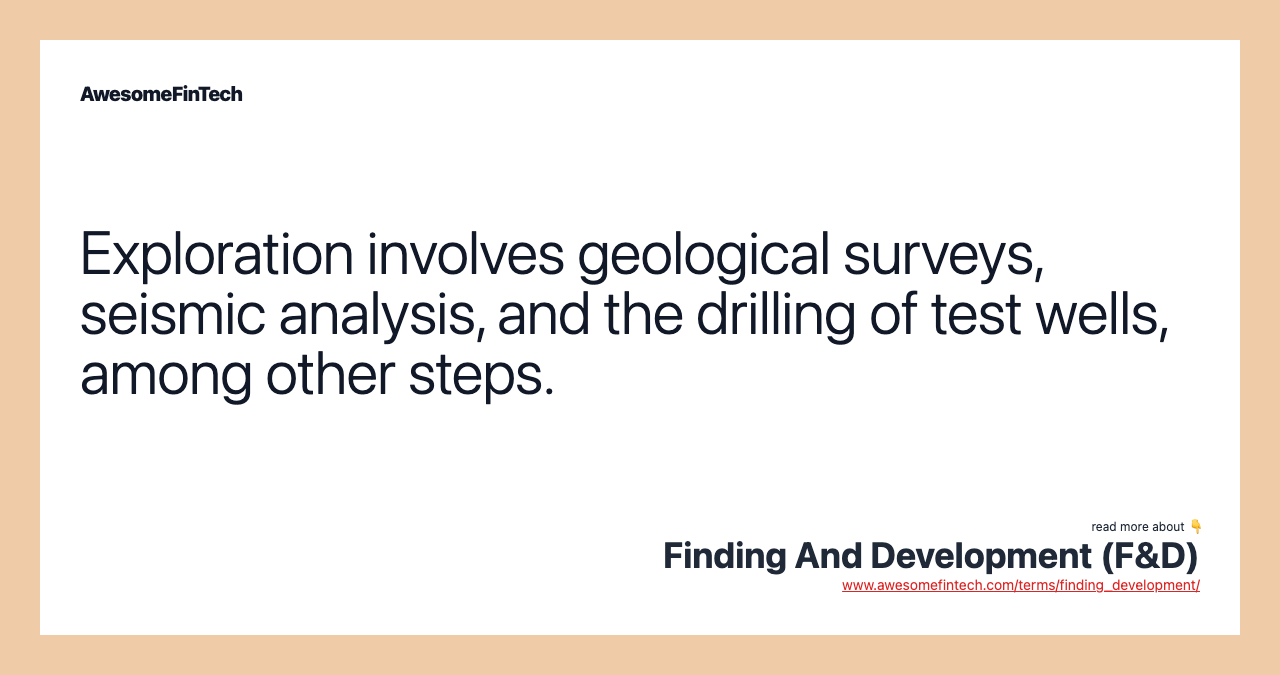Finding And Development (F&D)
Finding and development (F&D) While the term finding and development can relate to costs incurred by any type of commodity company, it is commonly used in regards to the upstream costs of an oil or gas business. Newer drilling technologies, prominent in the Marcellus and Bennett shale fields in Pennsylvania and Texas, allow companies such as Chesapeake Energy Corporation to extend horizontal legs about 5,000 feet from vertical wells in search of natural gas pockets, producing four times as much gas at only twice the cost of a vertical well. F&D costs are calculated by dividing the costs incurred during a period of time by the number of commodities found during that same time. As natural gas prices descended to historic lows in January 2016, many exploratory wells were shuttered as high production costs rendered extraction unprofitable.

What Is Finding And Development (F&D)?
Finding and development (F&D) refers to costs incurred when a company purchases, researches and develops properties in an effort to establish commodity reserves. Exploration and development businesses rely on finding commodities to manufacture and sell. Finding and development costs represent a cost of doing business for these types of companies.
Finding and development costs are also known as finding costs.



Understanding Finding And Development
While the term finding and development can relate to costs incurred by any type of commodity company, it is commonly used in regards to the upstream costs of an oil or gas business. In this case, the costs of finding and development can be expressed per barrel. Finding costs are calculated over a given period of time. During that period, the amount of money spent to locate additional commodity reserves is tallied then divided by the additional quantity of reserves actually discovered during that same time period.
F&D costs are calculated by dividing the costs incurred during a period of time by the number of commodities found during that same time. Oil is usually measured in barrels; gas is often measured by a given quantity of cubic feet.
Exploration Costs
Oil exploration & production involves locating and extracting nonrenewable resources from the Earth; the process of oil and gas exploration and production typically involves four stages.
Exploration
At this stage, the search for hydrocarbons beneath the ground entails geophysical prospecting for shale formations that hold deposits of oil and natural gas. One method of exploration involves seismology, a process whereby substantial vibrations, via explosives or machinery, are produced at the Earth’s surface. Seismic waves travel to the Earth’s mantle, and the respondent force is analyzed at the surface to identify layers of rock that trap reservoirs of oil and natural gas. Exxon Mobil Corporation maintains many large exploratory fields in the Gulf of Mexico, extending operations to 339 deepwater blocks.
Well Development
After identifying potentially viable fields, engineers determine the number of wells needed to meet production requirements and the method of extraction of the liquid hydrocarbons. Platform construction costs are estimated with regard to the site, offshore or onshore, and designs are rendered for systems used to facilitate environmental protections. Newer drilling technologies, prominent in the Marcellus and Bennett shale fields in Pennsylvania and Texas, allow companies such as Chesapeake Energy Corporation to extend horizontal legs about 5,000 feet from vertical wells in search of natural gas pockets, producing four times as much gas at only twice the cost of a vertical well.
Abandonment
As exploratory sites are deemed unproductive or existing operations exhaust capacity, companies plug wells and attempt to restore the areas to environmental states that existed prior to drilling activities. As natural gas prices descended to historic lows in January 2016, many exploratory wells were shuttered as high production costs rendered extraction unprofitable. In 2014, the state of Ohio ramped up efforts to plug nearly 600 orphan wells that posed hazards to surface water and aquifers.
Related terms:
Commodity
A commodity is a basic good used in commerce that is interchangeable with other goods of the same type. read more
Directional Drilling
Directional drilling is a technique used by oil-extraction companies in order to access oil in underground reserves. read more
Exploration & Production (E&P)
An exploration & production company is known to be in a specific sector within the oil and gas industry. read more
Hubbert's Peak Theory
Hubbert’s peak theory predicts the rise, peak, and decline of global oil production. read more
Nonrenewable Resources
A nonrenewable resource is a natural substance that is not replenished with the speed at which it is consumed. Its supply is finite. read more
Offshore
Offshore refers to a location outside of one's national boundaries, either land- or water-based. Learn about offshore banking, corporations, and investing. read more
Organic Reserve Replacement
An organic reserve replacement is when an oil company accumulates reserves via exploration and production as opposed to purchasing proven reserves. read more